No edit summary Tag: sourceedit |
|||
| (26 intermediate revisions by 4 users not shown) | |||
| Line 5: | Line 5: | ||
|pioneer=[[Cassius]] |
|pioneer=[[Cassius]] |
||
}} |
}} |
||
| − | The '''self-righting mechanism''' ( |
+ | The '''self-righting mechanism''' (more commonly referred to as '''srimech''', derived from the words '''s'''elf-'''ri'''ghting '''mech'''anism) is a device used by robots to flip itself back onto its wheels if it gets flipped over or stuck. Srimechs are one of two main methods of neutralising the effect of flipping, lifting and vertical spinning weapons, the other being [[Invertible Robots|invertible designs]]. |
| − | + | The first robot to attempt self-righting in the UK Series was [[Chaos 2|Chaos]], after being flipped over by [[Matilda]] during its [[Robot Wars: The Second Wars|Series 2]] [[Robot Wars: The Second Wars/Heat B#Final|Heat Final]] against [[Mace]]. However, the first successful use of a srimech in the UK Series was by [[Cassius]], also in Series 2, where it used its flipping arm to right itself after being overturned by [[Sir Killalot]] during its [[Pinball]] run. |
|
| − | == |
+ | ==Power Sources== |
| − | Usually, self-righting mechanisms are powered by either pneumatics (usually as part of a flipping weapon, [[Chaos 2]] and [[Cassius]] were some of the first robots to have utilised these systems) or by an electric motor powered by the battery |
+ | Usually, self-righting mechanisms are powered by either pneumatics (usually as part of a flipping weapon, [[Chaos 2]] and [[Cassius]] were some of the first robots to have utilised these systems) or by an electric motor powered by the battery ([[Hypno-Disc]], [[Panic Attack]] and robots built by [[Team Ranglebots]] used these somewhat rarer systems). However, there are also occasionally self-righting mechanisms powered by other means, such as [[Razer|Razer's]] self-righting wings which were moved up and down by a steel cable attached to the weapon, allowing the robot to self-right and perform its distinctive "salute". |
==Origins of the Srimech== |
==Origins of the Srimech== |
||
| − | [[File:Biohazard.jpg|thumb |
+ | [[File:Biohazard.jpg|thumb|Biohazard, the first machine ever to self-right]] |
| − | The origins of the self-righting mechanism lie not only in UK Robot Wars, but in the original US competition, |
+ | The origins of the self-righting mechanism lie not only in UK ''Robot Wars'', but also in the original US competition, with famous American robots such as [http://battlebots.wikia.com/wiki/BioHazard Biohazard] and [http://battlebots.wikia.com/wiki/Vlad_the_Impaler Vlad the Impaler]. |
| − | *In 1996, Biohazard defeated rival machine Vlad the Impaler by pinning it against the wall for 30 seconds. The match ended and Biohazard released its |
+ | *In the 1996 US competition, Biohazard defeated rival machine Vlad the Impaler by pinning it against the wall for 30 seconds. The match ended and Biohazard released its opponent, but Vlad the Impaler, apparently disappointed at the loss, turned and used its pneumatic lifting spikes on Biohazard to flip and immobilise it. Biohazard was able to self-right by use of its electric lifting arm. This is generally believed to be the first display of self-righting at a tournament, but it took place after the conclusion of a match and had no bearing on the outcome. |
[[File:Vlad-BBS3.jpg|thumb|Vlad the Impaler, the first robot to self-right during a battle]] |
[[File:Vlad-BBS3.jpg|thumb|Vlad the Impaler, the first robot to self-right during a battle]] |
||
| − | *In 1997, in another match between Biohazard and Vlad the Impaler, |
+ | *In 1997, in another match between Biohazard and Vlad the Impaler, the latter demonstrated its top-mounted self-righting mechanism, consisting of an adapted pneumatic ram that could quickly and repeatedly thrust Vlad the Impaler back upright from an inverted orientation. The device was successfully used by Vlad the Impaler to self-right from an immobilised position several times, but did not prevent it from losing the match on a judge's decision. |
| + | *Also in 1997, during a heavyweight melee, [[frenZy]] used its hammer to self-right after getting tipped upside-down by [[The Master#Outside Robot Wars|Snake]] and [http://battlebots.wikia.com/wiki/DooAll DooAll]. This was the first documented case of a robot achieving this feat with an [[Overhead weapons|overhead weapon]].<ref>https://www.youtube.com/watch?v=Q-evhuSTAkY#t=0m43s</ref> |
||
| − | [[File:Cassius. |
+ | [[File:Cassius S2.png|thumb|Cassius, pioneer of the srimech in UK competition, the first robot to self-right and manage to continue in the tournament]] |
| − | *In [[Robot Wars: The Second Wars]], Cassius was flipped onto its back by [[Sir Killalot]] during |
+ | *In [[Robot Wars: The Second Wars]], Cassius was flipped onto its back by [[Sir Killalot]] during its [[Robot Wars: The Second Wars/Semi-Final 2|Semi-Final]] [[Pinball]] run<ref>https://www.youtube.com/watch?list=PL096DCF9124F25F58&v=hXIreYJq-p0&feature=player_detailpage#t=389</ref>. Despite this, Cassius used its [[Front-hinged flippers|front-hinged flipping arm]] to self-right, landing on its wheels and managing to continue its run. This was the first occasion where a srimech had allowed a robot to continue in a tournament, as Cassius would progress to the Arena stage with its run. |
| − | *Later in that series, Cassius |
+ | *Later in that series, Cassius fought reigning UK Champion [[Roadblock]] in its [[Robot Wars: The Second Wars/Grand Final#Cassius (5) vs Roadblock (1)|Grand Final Eliminator]]. Cassius was once again flipped over during the battle, but used its flipping arm to throw itself back onto its wheels before proceeding to defeat Roadblock via knockout. This was the first ever recorded instance of a robot going on to win a battle after being flipped over. |
| − | The term was coined by [[Rex Garrod]] after Cassius self-righted for the first time. |
+ | The term was coined by [[Rex Garrod]] after Cassius self-righted for the first time. Cassius, Biohazard and Vlad the Impaler are all credited with the evolution of the self-righting mechanism, and are all members of [[The Combat Robot Hall of Fame]]. |
==Types== |
==Types== |
||
| − | During the show's history, there were |
+ | During the show's history, there were multiple different ways in which a robot could self-right: |
===Weapons=== |
===Weapons=== |
||
[[File:CassiusS2Pinball.jpg|thumb|Cassius self-rights for the first time]] |
[[File:CassiusS2Pinball.jpg|thumb|Cassius self-rights for the first time]] |
||
[[File:MortisSrimechS3.jpg|thumb|Mortis demonstrates its self-righting arm]] |
[[File:MortisSrimechS3.jpg|thumb|Mortis demonstrates its self-righting arm]] |
||
| − | [[File:Iron-Awe self-right.png|thumb|Iron-Awe, the first |
+ | [[File:Iron-Awe self-right.png|thumb|Iron-Awe, the first UK ''Robot Wars'' competitor to use an [[overhead weapon]] to self-right]] |
| + | [[File:Mute self righting Judge Shred 3.gif|thumb|Mute struggles to self right, whilst Judge Shred 3 gets another flip in]] |
||
[[File:Refbot counts out ceros.JPG|thumb|Ceros is counted out after losing power to its flipper]] |
[[File:Refbot counts out ceros.JPG|thumb|Ceros is counted out after losing power to its flipper]] |
||
| − | + | One of these methods was through the use of a robot's own weapon. This was first seen in Series 2, where eventual runner-up [[Cassius]] used its flipping arm to right itself after being flipped over on two occasions. Earlier in Series 2, [[Chaos 2|Chaos]] also attempted to self-right using its own flipping arm, but failed to do so. After Series 2, more robots began to be capable of righting themselves using their flippers, starting with [[Chaos 2]] in its [[Robot Wars: The Third Wars|Series 3]] [[Robot Wars: The Third Wars/Heat E#Heat Final|Heat Final]], with other flipper-wielding robots, including [[Firestorm]], [[Bigger Brother]], [[Thermidor 2]] and [[Apollo]], all proving capable of doing so in later series. |
|
| − | In Series 4, [[Iron-Awe]] became the first |
+ | In [[Robot Wars: The Fourth Wars|Series 4]], [[Iron-Awe]] became the first UK ''Robot Wars'' competitor to self-right using an axe, and this was followed by others including [[Dominator 2]], [[Terrorhurtz]] and [[Thor]] as the series progressed. Other forms of self-righting weapons included the lifting arms of [[Wild Thing]] and [[Mortis]], and the lifting scoop of [[Behemoth]], which was upgraded to do so for [[Robot Wars: Series 8|Series 8]]-[[Robot Wars: Series 10|10]]. |
| + | [[Robot Wars: Series 9|Series 9]] Grand Finalist [[Aftershock]] became the first robot to successfully incorporate a self-righting design using a spinning weapon. This is different to various other robots which have survived a flip with a lucky bounce off the spinner, as its disc and later asymmetrical bar spinner proved themselves reliable at self-righting. |
||
| − | The advantage of self-righting through use of a weapon is that focus can be put on the weapon itself without having to make room or weight allowances for a secondary mechanism to re-right the robot. The main disadvantage, however, is that they could be rendered ineffective if the weapon was damaged or disabled. In the case of pneumatic weapons, including flippers, hammers and axes, they could lose effectiveness over time with every usage due to their limited CO<sub>2</sub> supplies, and eventually be unable to self-right when it ran out. This ultimately cost robots like [[Chaos 2]], [[Tsunami]] and [[TR2]] throughout both the original and rebooted series. |
||
| + | |||
| + | The main advantage of self-righting through the use of a weapon is that all the design focus can be on exploiting the power from the weapon without having to accommodate extra self-righting mechanisms, therefore reducing the weight and power that can be put through the main weapon. The main disadvantage is that weapons are targets for opponents, and are also subject to damage or [[Malfunctions|malfunctions]]. These can adversely affect both the weapon's effectiveness and its capacity to self-right, or even result in the weapon failing completely. Pneumatic weapons, such as flippers and axes, are particularly susceptible to depletion as they run on limited CO<sub>2</sub> supplies, which will start to run out, either reducing the power of the weapon or causing it to stop firing altogether. This ultimately cost robots like [[Chaos 2]], [[Tsunami]] and [[TR2]] throughout both runs of ''[[Robot Wars]]''. |
||
{|class="wikitable" |
{|class="wikitable" |
||
| Line 42: | Line 46: | ||
!Notable robots |
!Notable robots |
||
|- |
|- |
||
| − | |[[Rear-hinged flippers|Rear-hinged |
+ | |[[Rear-hinged flippers|Rear-hinged flipper]] |
| − | |Robots are catapulted in an arch back onto their wheels. One of the most entertaining to watch but the one where CO<sub>2</sub> depletion is most problematic. Chaos 2 was the first to self-right successfully using this weapon type. |
+ | |Robots are catapulted in an arch back onto their wheels. One of the most entertaining to watch but the one where CO<sub>2</sub> depletion is most problematic. Chaos 2 was the first to self-right successfully using this weapon type (Series 3, Heat Final). |
| − | |[[Chaos 2]], [[ |
+ | |[[Chaos 2]], [[Dantomkia]], [[Apollo]] |
| ⚫ | |||
| − | |[[Rear-hinged flippers|Rear-hinged flipping arm]] |
||
| − | |Robots are catapulted in an arch back onto their wheels. Easier to use on an angle (when side-stranded), but also suffers from the same CO<sub>2</sub> problem as true flippers. |
||
| ⚫ | |||
| ⚫ | |||
| − | |[[Front-hinged flippers|Front-hinged true flipper]] |
||
| − | |Flipper activates and pushes body up and backwards until gravity pulls it back onto its wheels. Does not require an "explosive" flip but fails if pinned or does not have a clear space behind it. |
||
| − | |[[Firestorm|Firestorm 2-5]], [[G.B.H.|G.B.H. 2]], [[Mute]] |
||
|- |
|- |
||
| − | |[[Front-hinged flippers|Front-hinged |
+ | |[[Front-hinged flippers|Front-hinged flipper]] |
| − | | |
+ | |Flipper activates and pushes body up and backwards until gravity pulls it back onto its wheels. Does not require an "explosive" flip but fails if pinned or does not have a clear space behind it. The first type of srimech to work successfully on the show (Cassius, Series 2 Semi-Final). |
| − | |[[ |
+ | |[[Firestorm]], [[Mute]], [[Cassius]] |
|- |
|- |
||
|[[Lifters]] |
|[[Lifters]] |
||
| − | |The robot is heaved onto its wheels as the lifter opens. Lacks the powerful trajectory that rear-hinged flippers have. |
+ | |The robot is heaved onto its wheels as the lifter opens. Lacks the powerful trajectory that rear-hinged flippers have, and is usually slower. |
|[[Wild Thing]] (Series 4-5), [[Mortis]] |
|[[Wild Thing]] (Series 4-5), [[Mortis]] |
||
|- |
|- |
||
|[[Lifting scoops]] |
|[[Lifting scoops]] |
||
|Same motion as Lifters. Effectiveness depends on the weapon's design, size and power. |
|Same motion as Lifters. Effectiveness depends on the weapon's design, size and power. |
||
| − | |[[Behemoth]] (Series 8) |
+ | |[[Behemoth]] (Series 8-10), [[Shockwave]] |
|- |
|- |
||
| + | |[[Overhead Weapons]] |
||
| − | |[[Spiked axes]]/[[Bladed axes]]/[[Hammers]] |
||
| − | |Functions essentially in the same method as front-hinged |
+ | |Functions essentially in the same method as front-hinged flippers. Suffer from balancing issues if the robot is too wide or heavy (as seen in [[Bamm Bamm]]'s failure in [[Robot Wars: The Seventh Wars|Series 7]]), and from limited CO<sub>2</sub> supplies if pneumatically-powered. |
| − | |[[Dominator 2]], [[Iron-Awe]], [[Terrorhurtz]] |
+ | |[[Dominator 2]], [[Iron-Awe]] (Series 4, 6-7), [[Terrorhurtz]] |
|- |
|- |
||
|[[Vertical crushers]] |
|[[Vertical crushers]] |
||
| − | | |
+ | |TX-108, which competed in an unaired battle of ''[[Robot Wars Extreme: Series 1]]'', used a crushing arm which could push backwards as a srimech, negating the need for an additional mechanism. This allowed the robot to save weight, at the expense of slow self-righting, although TX-108 itself would not appear in televised combat. |
|[[TX-108]] |
|[[TX-108]] |
||
| ⚫ | |||
| ⚫ | |||
| ⚫ | |||
| ⚫ | |||
|- |
|- |
||
|[[Vertical flywheels]] |
|[[Vertical flywheels]] |
||
|The flywheel makes contact with the arena floor as the robot is inverted, 'kicking' it back onto its wheels. |
|The flywheel makes contact with the arena floor as the robot is inverted, 'kicking' it back onto its wheels. |
||
|[[Aftershock]] |
|[[Aftershock]] |
||
| ⚫ | |||
| + | |[[Bar spinners|Bar spinners (horizontal)]] |
||
| + | |When inverted, Apex could be spun up to full speed, and the gyroscopic imbalance caused the robot to naturally flip itself back over. However, this capability was never demonstrated in televised combat. |
||
| ⚫ | |||
| ⚫ | |||
| + | |[[Bar spinners|Bar spinners (vertical)]] |
||
| + | |Functions in the same method as vertical flywheels. |
||
| + | |[[Aftershock]] |
||
| ⚫ | |||
| + | |[[Unique weapons|Snapping jaw]] |
||
| + | |A jaw designed to snap downwards, which also exerts enough force when retracting to right the wielder. |
||
| + | |[[Bucky the Robot]] |
||
| ⚫ | |||
| + | |[[Bludgeoners]] |
||
| + | |If placed on one of its front-mounted tool spinners, the Series 10 version of Expulsion could self-right through gyroscopic precession. However, this capability was never demonstrated in televised combat.<ref>https://www.facebook.com/teamexpulsion/videos/545697705764247/</ref> |
||
| ⚫ | |||
| ⚫ | |||
| + | |[[Drums]] |
||
| + | |Although invertible, [[Concussion]] and [[Sabretooth|Sabretooth's]] drums in their Series 10 incarnations allowed each robot to self-right if inverted, using the gyroscopic forces acting on the robot as the drum spins.<ref>https://www.youtube.com/watch?v=btimsW9bd70</ref><ref>https://www.youtube.com/watch?v=sJa-XhSLOxo</ref> |
||
| + | |[[Concussion]] (Series 10), [[Sabretooth]] (Series 10) |
||
|} |
|} |
||
| Line 87: | Line 99: | ||
[[File:X-terminator_2_self_righting.JPG|thumb|The Series 4 X-Terminator's side spikes push it back onto its wheels]] |
[[File:X-terminator_2_self_righting.JPG|thumb|The Series 4 X-Terminator's side spikes push it back onto its wheels]] |
||
[[File:HypnoDiscselfrights.jpg|thumb|Hypno-Disc heaves itself back upright against Atomic 2]] |
[[File:HypnoDiscselfrights.jpg|thumb|Hypno-Disc heaves itself back upright against Atomic 2]] |
||
| + | [[File:Pulsar_srimech.jpg|thumb|Pulsar demonstrates its srimech arm]] |
||
[[File:Firestorm_vs_panic_attack.JPG|thumb|Panic Attack struggles to self-right against Firestorm 3]] |
[[File:Firestorm_vs_panic_attack.JPG|thumb|Panic Attack struggles to self-right against Firestorm 3]] |
||
[[File:ChaosRazer13Black1.jpg|thumb|Razer has one of its wings ripped off by 13 Black]] |
[[File:ChaosRazer13Black1.jpg|thumb|Razer has one of its wings ripped off by 13 Black]] |
||
| ⚫ | Not every weapon has a self-righting capability, so another form of srimech was a separate mechanism added to the robot, which existed in various forms across the show's history. These included top-mounted lids such as those found on the later incarnations of [[Panic Attack]], to the side-mounted bars of [[Hypno-Disc]] and [[Ironside3]], self-righting wings attached to crushers such as [[Razer]] and [[Ming|Ming 3]] or specific side spikes such as on the various incarnations of [[X-Terminator]]. They could either function by re-righting the robot when it was on its back, or from its sides where it was most susceptible to being stranded. |
||
| ⚫ | |||
| ⚫ | Not every weapon |
||
| − | These self-righting mechanisms had the advantage that they did not detract from the efficiency and longevity of a robot's weapon. At the same time, however, they could often be easily targeted by opponents, and, like weapon-based srimechs, were prone to failure if they were damaged or did not work properly. Additionally, they were generally less effective than weapon-based srimechs. This was of particular relevance to Panic Attack, whose self-righting lid rarely succeeded in fully righting the robot, and broke after [[Refbot]] tried to free it from the arena wall in the Extreme 2 Commonwealth Carnage. [[13 Black|13 Black's]] side-bar srimech was also susceptible to failing, which it did in both of its Series 7 battles, while Razer's wings were easily torn off by both [[Big Nipper]] and 13 Black during its appearances. |
+ | These self-righting mechanisms had the advantage that they did not detract from the efficiency and longevity of a robot's weapon. At the same time, however, they could often be easily targeted by opponents, and, like weapon-based srimechs, were prone to failure if they were damaged or did not work properly. Additionally, they were generally less effective than weapon-based srimechs. This was of particular relevance to Panic Attack, whose self-righting lid rarely succeeded in fully righting the robot, and broke after [[Refbot]] tried to free it from the arena wall in the [[Robot Wars Extreme: Series 2|Extreme 2]] [[Robot Wars Extreme: Series 2/Commonwealth Carnage|Commonwealth Carnage]]. [[13 Black|13 Black's]] side-bar srimech was also susceptible to failing, which it did in both of its Series 7 battles, while Razer's wings were easily torn off by both [[Big Nipper]] and 13 Black during its appearances. |
{|class="wikitable" |
{|class="wikitable" |
||
| Line 100: | Line 112: | ||
|- |
|- |
||
|Side-Bars |
|Side-Bars |
||
| − | |A small, top-mounted bar mechanism intended to push the robot sideways back onto its wheels. |
+ | |A small, top-mounted bar mechanism intended to push the robot sideways back onto its wheels. Hinged at one side by the edge of the robot, it was long enough to overcome any obstructions by the robot's weapons. |
| − | |[[Hypno-Disc]], [[13 Black]], [[Ironside3]] |
+ | |[[Hypno-Disc]], [[Kan-Opener]] (Series 5), [[13 Black]], [[Ironside3]] |
|- |
|- |
||
|Overhead Bar |
|Overhead Bar |
||
| + | |A bar mounted on the top of a robot designed to turn the robot back onto its wheels either forwards or backwards. Differs from side arms in that they are usually hinged at the front or the rear of the robot, pushing it back onto its wheels in a similar motion to front- or rear-hinged lifters. |
||
| − | |The Alien featured a variation of the bar-srimech that functioned overhead, turning the robot over its front. Notably, however, it malfunctioned in Series 5 after getting stuck on its own spinning hammer. |
||
| − | |[[The Alien]] |
+ | |[[The Alien]], [[Pulsar]], [[Magnetar]] |
|- |
|- |
||
| + | |Overhead Lids |
||
| − | |Rear "Lid" |
||
| − | |A |
+ | |A wide self-righting mechanism mounted on the top of a robot designed to turn the robot back onto its wheels either forwards or backwards. Ranging from multiple bars joined together (e.g. Cedric Slammer) to full-covered "lids" (e.g. the Series 4-5 and Extreme 1-2 versions of Panic Attack). They push the robot back onto its wheels using a similar motion to rear-hinged lifters. These srimechs were sometimes ineffective and prone to failure due to the slowness of their activation, with Panic Attack famously only self-righting once in three attempts. |
|[[Panic Attack]], [[Cedric Slammer]] |
|[[Panic Attack]], [[Cedric Slammer]] |
||
|- |
|- |
||
|Side Spikes |
|Side Spikes |
||
|Pneumatic spikes situated on either side of the robot, which would push it back over if it was positioned on its side. |
|Pneumatic spikes situated on either side of the robot, which would push it back over if it was positioned on its side. |
||
| − | |[[X-Terminator]](Series 3-4, Series 7) |
+ | |[[X-Terminator]] (Series 3-4, Series 7) |
|- |
|- |
||
|Side Arms |
|Side Arms |
||
|A mechanism very similar to the side spikes. Small arm-like mechanisms installed into the side of the robot which would push it back onto its wheels, and were attached close to the robot's base. |
|A mechanism very similar to the side spikes. Small arm-like mechanisms installed into the side of the robot which would push it back onto its wheels, and were attached close to the robot's base. |
||
| − | |[[ICU]], [[X-Terminator]](Series 5-6), [[Eric]] |
+ | |[[Behemoth]], [[ICU]], [[X-Terminator]] (Series 5-6), [[Eric]] |
| ⚫ | |||
| ⚫ | |||
| ⚫ | |The Series 4 version of Sir Chromalot featured a unique self-righting mechanism which was largely based on the side arm srimech. Supported by a large tower, a series of arms would push down on the robot, much like an umbrella, in an attempt to push it back onto its wheels. This srimech was never properly seen in action. |
||
| ⚫ | |||
| ⚫ | |||
| ⚫ | |||
| ⚫ | |||
| ⚫ | |||
|- |
|- |
||
|Wings |
|Wings |
||
|First, and most notably, used by Razer, these were most commonly seen in robots armed with vertical crushers. These were usually two blade- or wing-shaped mechanisms mounted either side of the robot, which were attached to the crusher by a cable, and would open when the crusher reached a certain angle. |
|First, and most notably, used by Razer, these were most commonly seen in robots armed with vertical crushers. These were usually two blade- or wing-shaped mechanisms mounted either side of the robot, which were attached to the crusher by a cable, and would open when the crusher reached a certain angle. |
||
|[[Razer]], [[Ming|Ming 3]], [[Chompalot]] |
|[[Razer]], [[Ming|Ming 3]], [[Chompalot]] |
||
| + | |- |
||
| ⚫ | |||
| ⚫ | |||
| + | |[[Nuts]] (Series 8) |
||
| + | |- |
||
| + | |Rotating Turret |
||
| + | |Modelled to look like a flamethrower previously used by [[Sergeant Bash]], a turret with sideways rotation, capable of turning the robot back onto its wheels. |
||
| + | |[[THE BASH]] (Series 10) |
||
| + | |- |
||
| ⚫ | |||
| ⚫ | |The Series 4 version of Sir Chromalot featured a unique self-righting mechanism which was largely based on the side arm srimech. Supported by a large tower, a series of arms would push down on the robot, much like an umbrella, in an attempt to push it back onto its wheels. This srimech was never properly seen in action. |
||
| ⚫ | |||
|} |
|} |
||
| − | === |
+ | ===Passive Designs=== |
[[File:Extreme_mini_morg.JPG|thumb|The rollover design of Mini Morg]] |
[[File:Extreme_mini_morg.JPG|thumb|The rollover design of Mini Morg]] |
||
| + | [[File:MightyMouse.png|thumb|The rollbar at the back of Mighty Mouse]] |
||
| ⚫ | |||
[[File:Robochicken_vs_mega_morg.JPG|thumb|Mega Morg lies stranded after the flip by Robochicken]] |
[[File:Robochicken_vs_mega_morg.JPG|thumb|Mega Morg lies stranded after the flip by Robochicken]] |
||
| + | Passive designs were self-righting mechanisms which did not require any moving parts to work. Mostly, they all included some kind of curved armour or bars designed to roll the robot back onto its wheels when it was flipped over. Robots such as [[The Morgue]] and [[Velocirippa]] were successful at surviving flips by opponents as the momentum of the flip allowed the shape to carry them back onto their wheels. |
||
| − | The third, and rarer, form of self-righting came from the robot's body. Some robots, such as [[Velocirippa]] and the [[The Morgue|Morgue]] series of robots, were designed as such that they would be able to roll back onto their wheels when they were flipped. Usually, these robots were semi-cylindrically shaped, and the srimech functioned similarly to the rollcage. The first robot to boast a roll-over body was Series 2 competitor, [[Ivanhoe]], with the most notable and successful examples being the Morgue series. |
||
| − | + | However, they all required sufficient space behind them to allow the robot to roll back over. The robots rarely had a backup srimech if the robot was trapped on a wall, leading to the robot becoming immobilised. It was also possible for the robot to become stranded on its back if the flip lacked momentum, or was in the wrong plane of attack. These shortcomings resulted in Ivanhoe's defeat in Series 2 as it was lifted onto its side by [[G.B.H.]], and Mega Morg's loss in Series 7 after it was flipped straight onto its back by [[Robochicken]], which was not the intended direction aimed for by the design. |
|
| + | |||
| + | {|class="wikitable" |
||
| + | !Srimech Type |
||
| + | !Description of srimech |
||
| + | !Notable robots |
||
| + | |- |
||
| + | |Rollover body shape |
||
| + | |A roughly Semi-circular shaped body shell allowed the robot to continue rolling after being flipped, eventually falling onto its wheels. Very effective when flipped sideways, but problematic when flipped from the front, as demonstrated by Mega Morg against Robochicken in Series 7. |
||
| + | |[[Ivanhoe]], [[Depoppesaurus Rex]], [[The Morgue]] |
||
| + | |- |
||
| + | |Rollbar |
||
| + | |One bar mounted high above the robot, which used the imbalanced centre of gravity of the robot to roll itself back onto its wheels. |
||
| + | |[[Velocirippa]], [[Mighty Mouse]] |
||
| + | |- |
||
| ⚫ | |||
| ⚫ | |||
| ⚫ | |||
| + | |} |
||
==References== |
==References== |
||
Revision as of 15:02, 28 March 2019
The self-righting mechanism (more commonly referred to as srimech, derived from the words self-righting mechanism) is a device used by robots to flip itself back onto its wheels if it gets flipped over or stuck. Srimechs are one of two main methods of neutralising the effect of flipping, lifting and vertical spinning weapons, the other being invertible designs.
The first robot to attempt self-righting in the UK Series was Chaos, after being flipped over by Matilda during its Series 2 Heat Final against Mace. However, the first successful use of a srimech in the UK Series was by Cassius, also in Series 2, where it used its flipping arm to right itself after being overturned by Sir Killalot during its Pinball run.
Power Sources
Usually, self-righting mechanisms are powered by either pneumatics (usually as part of a flipping weapon, Chaos 2 and Cassius were some of the first robots to have utilised these systems) or by an electric motor powered by the battery (Hypno-Disc, Panic Attack and robots built by Team Ranglebots used these somewhat rarer systems). However, there are also occasionally self-righting mechanisms powered by other means, such as Razer's self-righting wings which were moved up and down by a steel cable attached to the weapon, allowing the robot to self-right and perform its distinctive "salute".
Origins of the Srimech
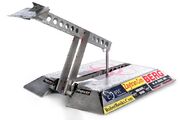
Biohazard, the first machine ever to self-right
The origins of the self-righting mechanism lie not only in UK Robot Wars, but also in the original US competition, with famous American robots such as Biohazard and Vlad the Impaler.
- In the 1996 US competition, Biohazard defeated rival machine Vlad the Impaler by pinning it against the wall for 30 seconds. The match ended and Biohazard released its opponent, but Vlad the Impaler, apparently disappointed at the loss, turned and used its pneumatic lifting spikes on Biohazard to flip and immobilise it. Biohazard was able to self-right by use of its electric lifting arm. This is generally believed to be the first display of self-righting at a tournament, but it took place after the conclusion of a match and had no bearing on the outcome.
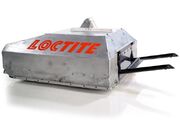
Vlad the Impaler, the first robot to self-right during a battle
- In 1997, in another match between Biohazard and Vlad the Impaler, the latter demonstrated its top-mounted self-righting mechanism, consisting of an adapted pneumatic ram that could quickly and repeatedly thrust Vlad the Impaler back upright from an inverted orientation. The device was successfully used by Vlad the Impaler to self-right from an immobilised position several times, but did not prevent it from losing the match on a judge's decision.
- Also in 1997, during a heavyweight melee, frenZy used its hammer to self-right after getting tipped upside-down by Snake and DooAll. This was the first documented case of a robot achieving this feat with an overhead weapon.[1]

Cassius, pioneer of the srimech in UK competition, the first robot to self-right and manage to continue in the tournament
- In Robot Wars: The Second Wars, Cassius was flipped onto its back by Sir Killalot during its Semi-Final Pinball run[2]. Despite this, Cassius used its front-hinged flipping arm to self-right, landing on its wheels and managing to continue its run. This was the first occasion where a srimech had allowed a robot to continue in a tournament, as Cassius would progress to the Arena stage with its run.
- Later in that series, Cassius fought reigning UK Champion Roadblock in its Grand Final Eliminator. Cassius was once again flipped over during the battle, but used its flipping arm to throw itself back onto its wheels before proceeding to defeat Roadblock via knockout. This was the first ever recorded instance of a robot going on to win a battle after being flipped over.
The term was coined by Rex Garrod after Cassius self-righted for the first time. Cassius, Biohazard and Vlad the Impaler are all credited with the evolution of the self-righting mechanism, and are all members of The Combat Robot Hall of Fame.
Types
During the show's history, there were multiple different ways in which a robot could self-right:
Weapons
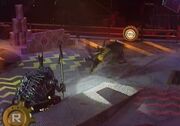
Cassius self-rights for the first time
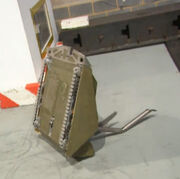
Mortis demonstrates its self-righting arm

Iron-Awe, the first UK Robot Wars competitor to use an overhead weapon to self-right
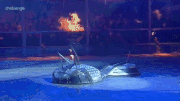
Mute struggles to self right, whilst Judge Shred 3 gets another flip in

Ceros is counted out after losing power to its flipper
One of these methods was through the use of a robot's own weapon. This was first seen in Series 2, where eventual runner-up Cassius used its flipping arm to right itself after being flipped over on two occasions. Earlier in Series 2, Chaos also attempted to self-right using its own flipping arm, but failed to do so. After Series 2, more robots began to be capable of righting themselves using their flippers, starting with Chaos 2 in its Series 3 Heat Final, with other flipper-wielding robots, including Firestorm, Bigger Brother, Thermidor 2 and Apollo, all proving capable of doing so in later series.
In Series 4, Iron-Awe became the first UK Robot Wars competitor to self-right using an axe, and this was followed by others including Dominator 2, Terrorhurtz and Thor as the series progressed. Other forms of self-righting weapons included the lifting arms of Wild Thing and Mortis, and the lifting scoop of Behemoth, which was upgraded to do so for Series 8-10.
Series 9 Grand Finalist Aftershock became the first robot to successfully incorporate a self-righting design using a spinning weapon. This is different to various other robots which have survived a flip with a lucky bounce off the spinner, as its disc and later asymmetrical bar spinner proved themselves reliable at self-righting.
The main advantage of self-righting through the use of a weapon is that all the design focus can be on exploiting the power from the weapon without having to accommodate extra self-righting mechanisms, therefore reducing the weight and power that can be put through the main weapon. The main disadvantage is that weapons are targets for opponents, and are also subject to damage or malfunctions. These can adversely affect both the weapon's effectiveness and its capacity to self-right, or even result in the weapon failing completely. Pneumatic weapons, such as flippers and axes, are particularly susceptible to depletion as they run on limited CO2 supplies, which will start to run out, either reducing the power of the weapon or causing it to stop firing altogether. This ultimately cost robots like Chaos 2, Tsunami and TR2 throughout both runs of Robot Wars.
| Srimech Type | Description of srimech | Notable robots |
|---|---|---|
| Rear-hinged flipper | Robots are catapulted in an arch back onto their wheels. One of the most entertaining to watch but the one where CO2 depletion is most problematic. Chaos 2 was the first to self-right successfully using this weapon type (Series 3, Heat Final). | Chaos 2, Dantomkia, Apollo |
| Front-hinged flipper | Flipper activates and pushes body up and backwards until gravity pulls it back onto its wheels. Does not require an "explosive" flip but fails if pinned or does not have a clear space behind it. The first type of srimech to work successfully on the show (Cassius, Series 2 Semi-Final). | Firestorm, Mute, Cassius |
| Lifters | The robot is heaved onto its wheels as the lifter opens. Lacks the powerful trajectory that rear-hinged flippers have, and is usually slower. | Wild Thing (Series 4-5), Mortis |
| Lifting scoops | Same motion as Lifters. Effectiveness depends on the weapon's design, size and power. | Behemoth (Series 8-10), Shockwave |
| Overhead Weapons | Functions essentially in the same method as front-hinged flippers. Suffer from balancing issues if the robot is too wide or heavy (as seen in Bamm Bamm's failure in Series 7), and from limited CO2 supplies if pneumatically-powered. | Dominator 2, Iron-Awe (Series 4, 6-7), Terrorhurtz |
| Vertical crushers | TX-108, which competed in an unaired battle of Robot Wars Extreme: Series 1, used a crushing arm which could push backwards as a srimech, negating the need for an additional mechanism. This allowed the robot to save weight, at the expense of slow self-righting, although TX-108 itself would not appear in televised combat. | TX-108 |
| Vertical flywheels | The flywheel makes contact with the arena floor as the robot is inverted, 'kicking' it back onto its wheels. | Aftershock |
| Bar spinners (horizontal) | When inverted, Apex could be spun up to full speed, and the gyroscopic imbalance caused the robot to naturally flip itself back over. However, this capability was never demonstrated in televised combat. | Apex |
| Bar spinners (vertical) | Functions in the same method as vertical flywheels. | Aftershock |
| Snapping jaw | A jaw designed to snap downwards, which also exerts enough force when retracting to right the wielder. | Bucky the Robot |
| Bludgeoners | If placed on one of its front-mounted tool spinners, the Series 10 version of Expulsion could self-right through gyroscopic precession. However, this capability was never demonstrated in televised combat.[3] | Expulsion (Series 10) |
| Drums | Although invertible, Concussion and Sabretooth's drums in their Series 10 incarnations allowed each robot to self-right if inverted, using the gyroscopic forces acting on the robot as the drum spins.[4][5] | Concussion (Series 10), Sabretooth (Series 10) |
Separate Mechanisms
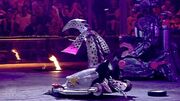
Razer raises its wings
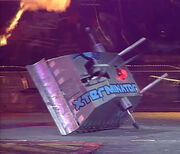
The Series 4 X-Terminator's side spikes push it back onto its wheels
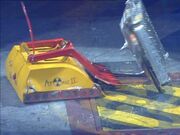
Hypno-Disc heaves itself back upright against Atomic 2

Pulsar demonstrates its srimech arm
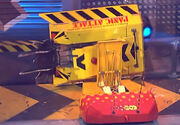
Panic Attack struggles to self-right against Firestorm 3
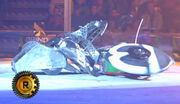
Razer has one of its wings ripped off by 13 Black
Not every weapon has a self-righting capability, so another form of srimech was a separate mechanism added to the robot, which existed in various forms across the show's history. These included top-mounted lids such as those found on the later incarnations of Panic Attack, to the side-mounted bars of Hypno-Disc and Ironside3, self-righting wings attached to crushers such as Razer and Ming 3 or specific side spikes such as on the various incarnations of X-Terminator. They could either function by re-righting the robot when it was on its back, or from its sides where it was most susceptible to being stranded.
These self-righting mechanisms had the advantage that they did not detract from the efficiency and longevity of a robot's weapon. At the same time, however, they could often be easily targeted by opponents, and, like weapon-based srimechs, were prone to failure if they were damaged or did not work properly. Additionally, they were generally less effective than weapon-based srimechs. This was of particular relevance to Panic Attack, whose self-righting lid rarely succeeded in fully righting the robot, and broke after Refbot tried to free it from the arena wall in the Extreme 2 Commonwealth Carnage. 13 Black's side-bar srimech was also susceptible to failing, which it did in both of its Series 7 battles, while Razer's wings were easily torn off by both Big Nipper and 13 Black during its appearances.
| Srimech Type | Description of srimech | Notable robots |
|---|---|---|
| Side-Bars | A small, top-mounted bar mechanism intended to push the robot sideways back onto its wheels. Hinged at one side by the edge of the robot, it was long enough to overcome any obstructions by the robot's weapons. | Hypno-Disc, Kan-Opener (Series 5), 13 Black, Ironside3 |
| Overhead Bar | A bar mounted on the top of a robot designed to turn the robot back onto its wheels either forwards or backwards. Differs from side arms in that they are usually hinged at the front or the rear of the robot, pushing it back onto its wheels in a similar motion to front- or rear-hinged lifters. | The Alien, Pulsar, Magnetar |
| Overhead Lids | A wide self-righting mechanism mounted on the top of a robot designed to turn the robot back onto its wheels either forwards or backwards. Ranging from multiple bars joined together (e.g. Cedric Slammer) to full-covered "lids" (e.g. the Series 4-5 and Extreme 1-2 versions of Panic Attack). They push the robot back onto its wheels using a similar motion to rear-hinged lifters. These srimechs were sometimes ineffective and prone to failure due to the slowness of their activation, with Panic Attack famously only self-righting once in three attempts. | Panic Attack, Cedric Slammer |
| Side Spikes | Pneumatic spikes situated on either side of the robot, which would push it back over if it was positioned on its side. | X-Terminator (Series 3-4, Series 7) |
| Side Arms | A mechanism very similar to the side spikes. Small arm-like mechanisms installed into the side of the robot which would push it back onto its wheels, and were attached close to the robot's base. | Behemoth, ICU, X-Terminator (Series 5-6), Eric |
| Wings | First, and most notably, used by Razer, these were most commonly seen in robots armed with vertical crushers. These were usually two blade- or wing-shaped mechanisms mounted either side of the robot, which were attached to the crusher by a cable, and would open when the crusher reached a certain angle. | Razer, Ming 3, Chompalot |
| Rotating Ring | A large, rotating, metal ring around the robot that can tip it back on its wheels as well as flipping/lifting other robots. | Nuts (Series 8) |
| Rotating Turret | Modelled to look like a flamethrower previously used by Sergeant Bash, a turret with sideways rotation, capable of turning the robot back onto its wheels. | THE BASH (Series 10) |
| Tower Mechanism | The Series 4 version of Sir Chromalot featured a unique self-righting mechanism which was largely based on the side arm srimech. Supported by a large tower, a series of arms would push down on the robot, much like an umbrella, in an attempt to push it back onto its wheels. This srimech was never properly seen in action. | Sir Chromalot (Series 4) |
Passive Designs

The rollover design of Mini Morg
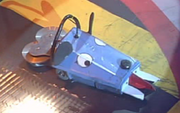
The rollbar at the back of Mighty Mouse
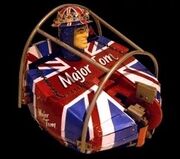
The Series 6 version of Major Tom, showing the rollcage
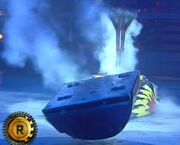
Mega Morg lies stranded after the flip by Robochicken
Passive designs were self-righting mechanisms which did not require any moving parts to work. Mostly, they all included some kind of curved armour or bars designed to roll the robot back onto its wheels when it was flipped over. Robots such as The Morgue and Velocirippa were successful at surviving flips by opponents as the momentum of the flip allowed the shape to carry them back onto their wheels.
However, they all required sufficient space behind them to allow the robot to roll back over. The robots rarely had a backup srimech if the robot was trapped on a wall, leading to the robot becoming immobilised. It was also possible for the robot to become stranded on its back if the flip lacked momentum, or was in the wrong plane of attack. These shortcomings resulted in Ivanhoe's defeat in Series 2 as it was lifted onto its side by G.B.H., and Mega Morg's loss in Series 7 after it was flipped straight onto its back by Robochicken, which was not the intended direction aimed for by the design.
| Srimech Type | Description of srimech | Notable robots |
|---|---|---|
| Rollover body shape | A roughly Semi-circular shaped body shell allowed the robot to continue rolling after being flipped, eventually falling onto its wheels. Very effective when flipped sideways, but problematic when flipped from the front, as demonstrated by Mega Morg against Robochicken in Series 7. | Ivanhoe, Depoppesaurus Rex, The Morgue |
| Rollbar | One bar mounted high above the robot, which used the imbalanced centre of gravity of the robot to roll itself back onto its wheels. | Velocirippa, Mighty Mouse |
| Rollcage | A series of bars mounted on top of the robot to help it roll back over if it was flipped. The main difference between rollcages and the rollover design used by other robots is that the bars are exposed and separate from the robot, often leaving them vulnerable to being damaged in the process. | Spikasaurus, Major Tom (Series 6) |
References
- ↑ https://www.youtube.com/watch?v=Q-evhuSTAkY#t=0m43s
- ↑ https://www.youtube.com/watch?list=PL096DCF9124F25F58&v=hXIreYJq-p0&feature=player_detailpage#t=389
- ↑ https://www.facebook.com/teamexpulsion/videos/545697705764247/
- ↑ https://www.youtube.com/watch?v=btimsW9bd70
- ↑ https://www.youtube.com/watch?v=sJa-XhSLOxo
| ||||||||||||||||||||||||||||||||
